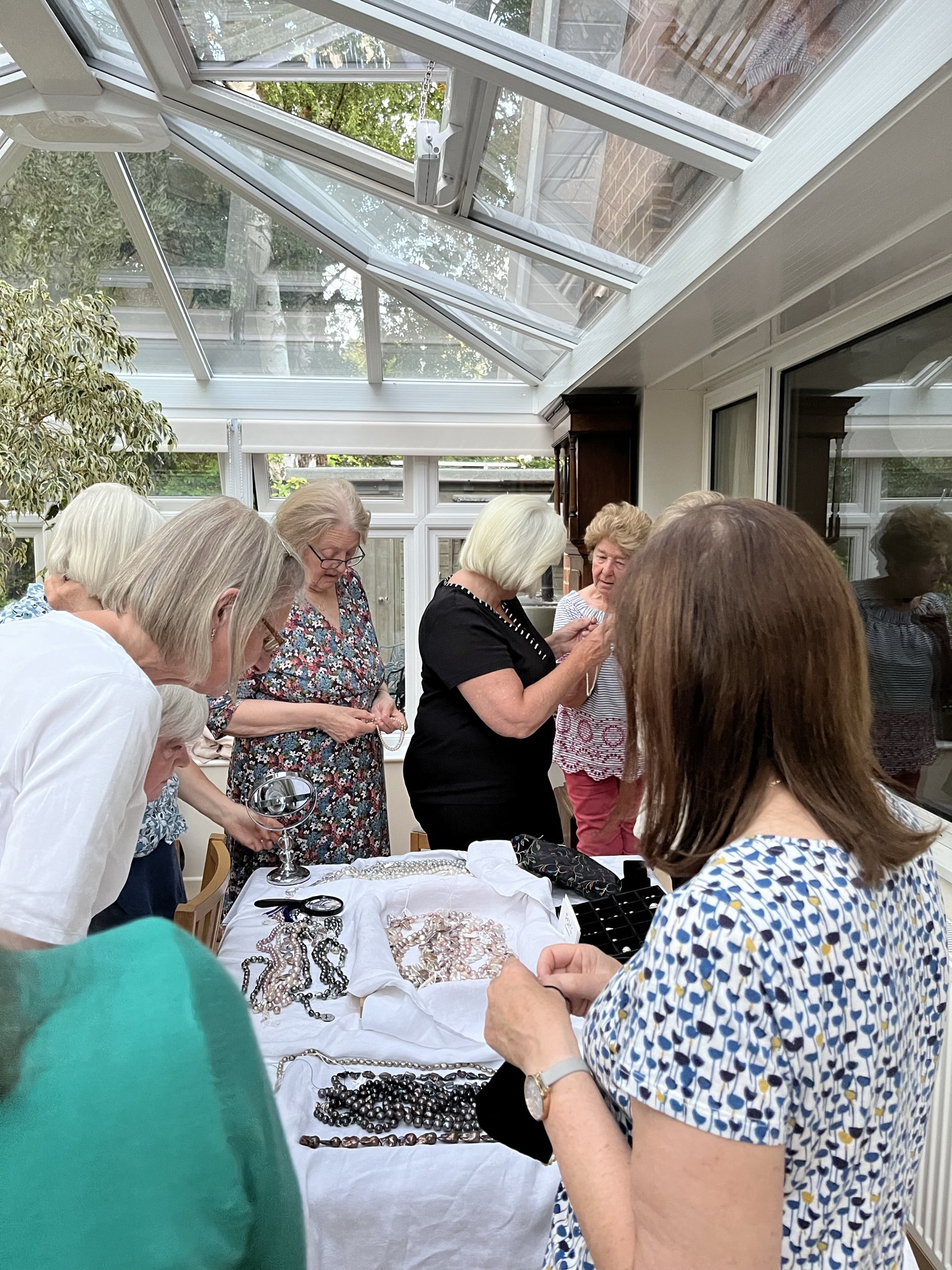On a sunny evening in early June, to take advantage of the light, we invited Elizabeth Ann to talk to us about pearls. She is passionate about pearls and keen to share her enthusiasm and love for them with others.
She began by explaining the different types of pearls and their history. There are four types of pearl – natural, farmed (also known as cultured pearls), simulated and imitation. Natural and farmed pearls are made up of calcium carbonate and conchiolin. The value of a pearl depends on size, lustre, shape and perfection. A strand of perfectly matched natural pearls could set you back £250,000!
A pearl can form in any mollusc, not just an oyster, and in fresh water or salt water species. Freshwater pearl colonies are protected in Scotland. It is not known how long a naturally occurring pearl takes to form, layers of calcium carbonate are produced by the oyster to cover a foreign body (not usually a grain of sand, but more likely other organic material, parasites or even damaged mantle tissue which has been displace within the shell) and of course the mollusc only produces one pearl in its lifetime. Many oysters are opened and discarded in the search for naturally occurring pearls, though I believe the meat is eaten. To produce a high quality pearl the shellfish needs to be healthy, live in clean water, and have a good diet. Pollution and bad weather can destroy an entire pearl crop.
Pearls have always been highly prized and some have been found in ancient burials. During the Age of Discovery the finest pearls from South America were presented to European monarchs. Portraits show them wearing pearl encrusted clothing. The pearls on Elizabeth I’s clothing are believed to be simulated.
Large and unusually shaped pearls – known as Baroque pearls – were highly sought after during the Renaissance and used for earrings or pendants; see Vermeer’s painting Girl with a pearl earring and royal portraits from the period. They are still used for jewellery today.
The earliest farmed pearl is believed to have been created by a 13th century Buddhist monk who inserted a small Buddha figure into a mollusc shell which produced a Buddha shaped pearl! (Perhaps he was bored?) But production of farmed pearls began in quantity in the late 19th century. Pearls are available in many shapes – flat squares, discs, lozenges etc. created by ‘seeding’ the appropriate shape into the mollusc shell. It is estimated that with careful management a farmed mollusc can produce 18-24 pearls in its lifetime.
Pearls come in a range of colours from white and cream through pink / green / to black. Though ‘black’ pearls – farmed in Tahiti – can be black, green or white. The colour of a pearl is determined by the colour of the lip on the mollusc shell. Artificially coloured pearls are treated with metal oxides to produce similar colours to those naturally occurring at a lower price.
The largest pearls come from the South Seas from the white lipped or gold lipped oyster – the oyster shell can be one foot in diameter so produces a correspondingly large – and expensive -pearl. Today most farmed pearls are from Japan (Lake Biwa), Australia (Broome), Tahiti and South East Asia.
Simulated pearls are usually created from a glass or other type of spherical bead coated in layers of fish scales to produce an iridescent finish. Imitation pearls are the cheapest type available. However, it is difficult to tell natural pearls from cultured and simulated pearls – even experts need a jeweller’s loupe (powerful magnifying lens) and good light to be able to tell the difference.
Finally Elizabeth Ann’s advice on pearls:
Keep your pearls away from perfume and cosmetics, (real pearls dissolve in acid)
Get your pearls restrung (knotted) every year – even if you don’t wear them
Make sure you have the right colour, length of strand and pearl size to suit you
A long strand can be gently twisted to create a more flattering shorter double strand
An overlong strand that is too short to be twisted can be worn with the clasp placed between two pearls to make the best length for you
3 things matter: love your pearls, make sure they love you (see advice above) and love the price!


